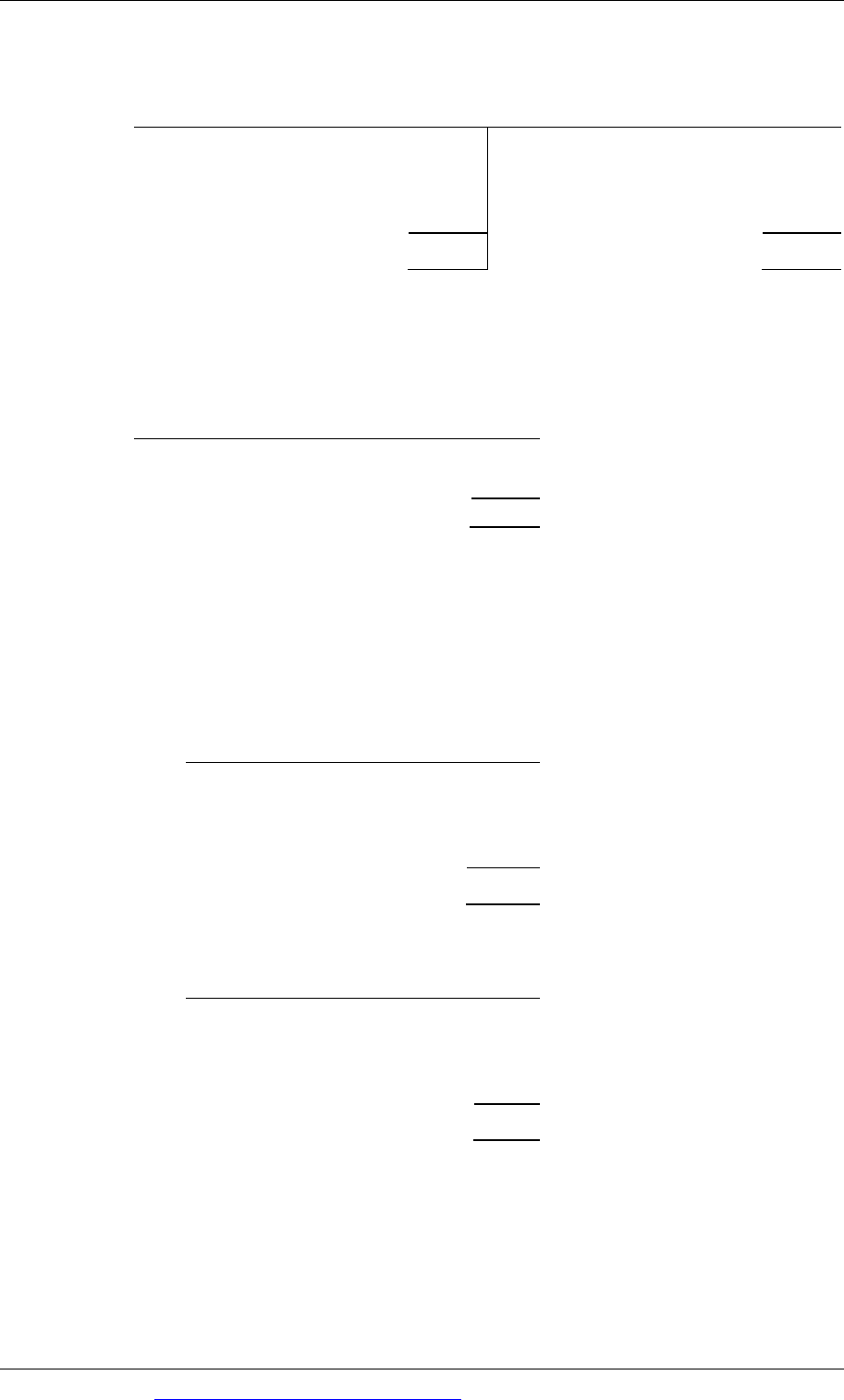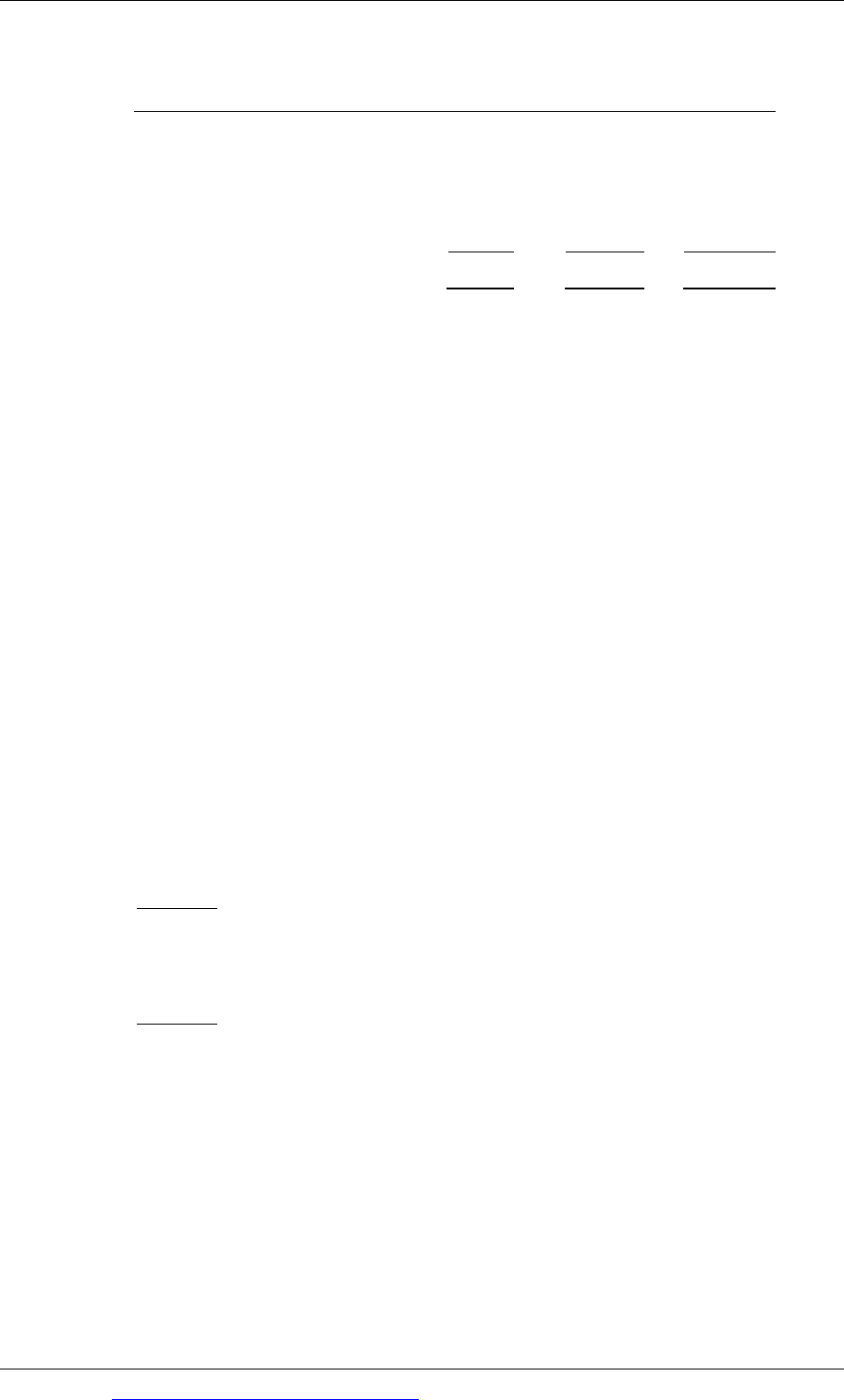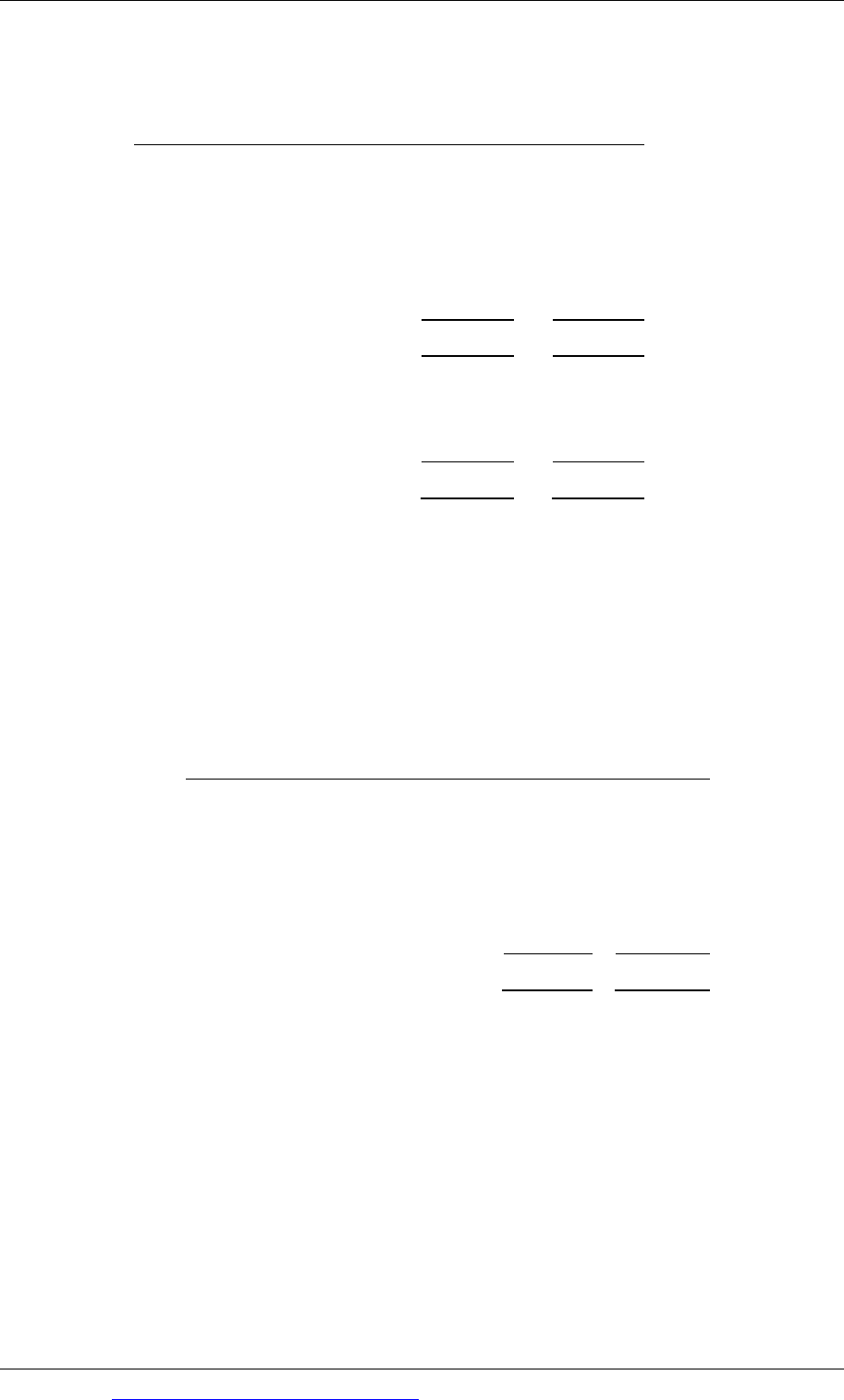ACCA P2 (INT) Corporate Reporting - Study text - 2010 (Emile Woolf)
Подождите немного. Документ загружается.


Answers
© EWP Go to www.emilewoolfpublishing.com for Q/As, Notes & Study Guides 613
(3) Taxation
Taxation
$000
$000
Cashpaid 2,400 Balanceb/d 2,400
Balancec/d 2,950 Incomestatement 2,950
5,350
5,350
18 IMPS
(a) Impairment loss
$m
Carryingvalue
500
Recoverableamount (385)
Impairmentloss
115
Recoverable amount is value in use (Working 1) as this is higher than net
realisable value (Working 2).
Workings
(1) Value in use:
Forecast cash flows discounted at 12%:
$m
Year1(185×0.893)
165.2
Year2(160×0.797) 127.5
Year3(130×0.712)
92.6
Total
385.3
(2) Net realisable value:
$m
Goodwill
0
Freehold 270
Freeholdlandandbuildings
50
320
(b) Treatment of impairment loss
IAS 36 requires the impairment loss to be allocated to the various non-current
assets in the following order: firstly, goodwill, secondly, to other assets, either
pro-rata or on another more appropriate basis.

PaperP2: Corporate reporting (International)
614 Go to www.emilewoolfpublishing.com for Q/As, Notes & Study Guides © EWP
Before
impairment
Impairment
loss(W1)
After
impairment
$m
$m
$m
Goodwill 70
(70)
‐
Landandbuildings
320
(33)
287
Plantandmachinery
110
(12)
98
500
(115)
385
Because the land and buildings have been re-valued, the impairment is treated
as a revaluation decrease until the carrying amount of the asset reaches its
depreciated historical cost. The revaluation reserve relating to the asset is $65
million and so is adequate to cover the full impairment of $33m. The
impairment must be separately disclosed and the notes to the accounts must
specify by class of asset the impairment recognised directly to equity.
The impairment loss on the goodwill and plant ($66 million) must be
recognised in profit or loss for the year. The notes to the accounts must specify
the line item in which the impairment loss has been included.
Where the impairment write-down is material, information must also be
provided as to the events and circumstances that led to the loss, the nature of
the assets affected, the segment to which the asset belongs, that recoverable
amount was based on value in use and the discount rate used to calculate this.
Workings
Loss on the various non-current assets
After the impairment loss has been recognised on the goodwill there is still
115 - 70 = 45 loss to be allocated to the other non current assets, on a pro-rata
basis.
Loss on land and buildings:
320
320 +110
x 45 = 33
Loss on plant and machinery:
110
320 +110
x 45 = 12
19 Prima
Holiday villas
IAS 16 allows property, plant and equipment to be re-valued or left at historical
cost. Revaluation should be based on the fair value (the open market value in an
arm’s length transaction). Revaluation is not required every year, but must be
conducted when it is believed that the fair value differs materially from the carrying
value.

Answers
© EWP Go to www.emilewoolfpublishing.com for Q/As, Notes & Study Guides 615
The method of accounting for the villa that is to be sold is covered by IFRS 5 which
requires that where, at the end of a reporting period, an asset is held for sale it
should be reclassified, re-measured and no longer depreciated. An asset is only
classified as held for sale where the following conditions are all met:
The asset is available for sale in its present condition.
The sale is believed to be highly probable:
−
Appropriate level of management is committed to the sale;
−
There is an active programme underway to find a buyer;
−
The asset is marketed at a realistic price.
Completion of sale expected within 12 months of classification.
From the limited information provided it appears that these conditions have been
met and therefore, under the rules of IFRS 5, the villa should be re-measured to the
lower of its carrying value and its fair value minus costs to sell.
Therefore, the villas should be valued at 31 December Year 4 as follows:
Fair
value
Carrying
value
$
$
Allvillas 25
20
Propertyheldforsale
(1)
(1.25)
Propertiestoberetained
24
18.75
The villas to be retained should be re-valued to $24m, resulting in an increase in the
revaluation reserve of $5.25m (24-18.75).
The villa to be sold should be written down from its carrying value to its fair value
minus costs to sell of $0.95m ($1m – 50,000). This impairment of $300,000 (1.25m –
0.95m) will be charged against the revaluation reserve for this asset. If there is
insufficient revaluation reserve, then the write down must be charged to profit or
loss.
The villa held for sale must be re-classified from ‘Non-current assets’ to ‘Current
assets’ as a separate line item.
Depreciation should not be charged when an asset has been classified as held for
sale. However, the other villas should be depreciated. IAS 16 states that expenditure
on repairs and maintenance does not remove the need to depreciate an asset. The
villas have a finite useful life and therefore must be depreciated. If the residual
value of these assets is greater than the carrying value then the depreciation charge
will be zero. It is not acceptable therefore to have a policy of non-depreciation on
such assets, and a prior year adjustment should be made to correct the error if the
error is material.
Head office
The head office should be recorded under property, plant and equipment at cost.
IAS 23 (revised 2007) requires that borrowing costs should be capitalised as part of

PaperP2: Corporate reporting (International)
616 Go to www.emilewoolfpublishing.com for Q/As, Notes & Study Guides © EWP
the cost of an asset if they are directly attributable to the acquisition, construction or
production of a ‘qualifying asset’. A qualifying asset is an asset that necessarily
takes a long period of time to get ready for its intended use or sale.
In this situation the company is therefore required to capitalise the borrowing costs
as part of the asset cost. Capitalisation must cease when the asset is substantially
complete. Construction finished on 31 May Year 4 and, although minor
modifications continued for a further three months, the standard states that minor
modifications indicate that the asset is substantially complete.
Costat30JuneYear4:
$000
$000
Land
1,000
Building: Constructioncost 8,000
Interest9%×5million×20/12(1.10×2to1.6×4) 750
8,750
Total
9,750
Prima is to receive a government grant. IAS 20 requires that the grant be recognised
when there is reasonable assurance that the entity will meet any conditions and
receive the grant. As the grant has not been received, a receivable will be recorded
under current assets. The credit can be treated in one of two ways:
Option 1: Record as deferred income and release to profit or loss over the useful
life of the asset
Option 2: Deduct the grant from the carrying amount of the asset.
If the second option is taken, the asset will be carried at $8.25m rather than at
$9.75m. The effect on profit or loss will be the same in both cases.
Land should not normally be depreciated, because land has an indefinite useful life
in most situations. However, as buildings have a limited useful life, a residual value
must be allocated to the building and the depreciable amount must then be written
off over the 50 year useful life. Depreciation will be charged in Year 4 for the four
months from 1 September to 31 December.
The estimates of residual value and useful life must be revised each year and the
depreciation amended prospectively.
Yachts
It is important to note that the yachts are held for rental purposes, so they are non-
current assets, not inventory.
The yachts cost $20m to build, but the recoverable amount on completion (higher of
value in use and net selling price) is only $18m, and so the assets must be initially
recognised at their recoverable amount. The impairment write down of $2m will be
charged to profit or loss in 20Year 4 in accordance with IAS 36.

Answers
© EWP Go to www.emilewoolfpublishing.com for Q/As, Notes & Study Guides 617
Cost Recoverableamount
$ $
Engines(15%) 3
2.7
Interior(25%)
5
4.5
Remainder(60%)
12
10.8
20
18
IAS 16 requires that each part of the asset that has a cost that is significant in relation
to the total cost must be depreciated separately. Therefore, in the first year the
depreciation charge will be as follows:
Engines $2.7m×1/3×9/12= $0.675m
Interior
$4.5m×1/2×9/12= $1.688m
Remainder
$10.8m×1/5×9/12= $1.620m
ChargetoprofitorlossinYear4
$3.983m
20 Financial instruments
(a) IAS 39 requires that, initially, all financial instruments be recorded at cost.
Only in rare circumstances (see below) may the investment remain at
historical cost. In most cases the instrument will be recorded at fair value or
amortised cost.
When a financial instrument is acquired or issued it must be classified into
one of four asset categories or one of two liability categories. The classification
will then determine the re-measurement model at the end of each subsequent
reporting period. The position can be set out as follows:
Financialassets Financialliabilities
Fairvaluethroughprofitorloss
Fairvalue Fairvalue
Heldtomaturity Amortisedcost
Loansandreceivables
Amortisedcost
Availableforsale
Fairvalue
Other
Amortisedcost
The three valuation models are:
(i) Historical cost
This model must only be used for investments in equity instruments
where there is no active quoted market price and the fair value cannot
otherwise be reliably determined. Derivatives linked to such
instruments are also permitted to be carried at historical cost.

PaperP2: Corporate reporting (International)
618 Go to www.emilewoolfpublishing.com for Q/As, Notes & Study Guides © EWP
(ii) Amortised cost
Amortised cost is calculated as:
Initial cost recognised
Plus: Interest at the effective rate
Minus: Cash received/paid
This model is used to measure the following instruments:
Assets held to maturity – non-derivative financial assets with fixed
or determinable payments and a fixed maturity. The entity must
have positive intention and financial ability to hold these
investments to maturity. It will not contain investments that have
been designated as fair value through profit or loss, available for sale
or where the investments meet the definition of loans and
receivables.
Loans and receivables – non-derivative financial assets with fixed or
determinable payments that are not quoted in an active market. It
will not contain investments that are held for trading or otherwise
designated as fair value through profit or loss nor designated as
available for sale.
Financial liabilities not treated as fair value through profit or loss.
(iii)
Fair value
Fair value is the amount for which an asset can be exchanged or a
liability settled, between knowledgeable and willing parties in an arm’s
length transaction. This model is used as follows:
Fair value through profit or loss – where the financial asset or
liability is either:
−
held for short term trading, or
−
a derivative not accounted for under hedging rules, or
−
designated as such upon initial recognition.
Available for sale – those financial assets are not classified or
designated as fair value through profit or loss, nor classified as loans
and receivables or held to maturity.
(b) (i)
3% Bond
The bond must initially be recorded at its purchase price of $250,000. If
classified as ‘held to maturity’, it must be re-measured at the end of the
reporting period to its amortised cost. The market value is not relevant.
Interest will be credited to profit or loss using the effective interest rate,
resulting in finance income of $24,250 (9.7% × 250,000). The effective rate
reflects the total return received by the investor over the duration of the
bond – being the coupon + $50,000 premium on redemption. The
coupon recorded in the statement of cash flows is $9,000 (3% × 300,000).
The difference between the effective interest and the actual coupon is
added to the investment to give an amortised cost at the end of Year 3 of
$265,250 (250,000 + 24,250 – 9,000).

Answers
© EWP Go to www.emilewoolfpublishing.com for Q/As, Notes & Study Guides 619
(ii) Equity shares in XYZ
The shares will initially be recorded at their cost of $30,000. As they have
been classed as ‘fair value through profit or loss’ the transaction costs
must be expensed to profit or loss immediately. At the end of each
reporting period, the shares must be re-measured to their market value,
with the resulting gain or loss being taken to profit or loss.
At 1
January Year 3, the investment has a carrying value of $34,000. By
the 31
December Year 3 this value is now $35,000. A $1,000 gain will
therefore be recognised in profit or loss for the year.
Even though the investment is no longer intended for sale in the short
term, it must remain classified as fair value through profit or loss as IAS
39 does not permit reclassification into or out of this category.
(iii)
Convertible bond
A convertible bond represents a compound instrument. In essence,
issuing a convertible bond is equivalent to issuing a non-convertible
bond plus a call option on the entity’s shares. Therefore, the investment
should be divided into a liability portion and an equity portion.
To establish the liability (debt) element, the future cash flows from the
bond are discounted at the normal market rate to establish the value of
an equivalent but redeemable bond.
Using a rate of 7% this gives a net present value of:
20,000
1.07
+
20,000
1.07
2
+
520,000
1.07
3
= $460,635
As the bond was issued for $500,000, it implies that the call option
embedded within the bond was sold for $39,365 ($500,000 – 460,635).
Therefore, the proceeds of $500,000 will be shown in the statement of
cash flows as a financing cash flow, and the credit will be split into non-
current liabilities $360,635 and equity $39,365.
21 HAM
(a) Charge to profit or loss: operating lease treatment
Yearsended31
December
Year7 Year8
ItemA
10,000 10,000
ItemB
15,000 15,000
25,000 25,000

PaperP2: Corporate reporting (International)
620 Go to www.emilewoolfpublishing.com for Q/As, Notes & Study Guides © EWP
(b) Charge to profit or loss: finance lease treatment
Yearsended31
December
Year7
Year8
$
$
Depreciation:
ItemA‐80,000/10 8,000
8,000
ItemB‐117,000/12
9,750
9,750
17,750
17,750
Financecosts:
ItemA‐Giveninquestion 2,545
2,182
ItemB–Giveninquestion
5,867
5,133
8,412
7,315
(c) Statement of financial position
(i) Accounting policy note: as required by IAS 1
The capital element of leased asset repayments is treated as a separate
category within non-current assets. Depreciation of leased assets is
consistent with the company’s policy for owned assets as found in note x.
(ii)
Non-current assets
Yearsended31December
Year7
Year8
$
$
Leasedmachinery
Cost(working(1))
197,000
197,000
Depreciation(working(2))
51,500
69,250
Netbookvalue
145,500
127,750

Answers
© EWP Go to www.emilewoolfpublishing.com for Q/As, Notes & Study Guides 621
(iii) Capital amounts due on finance leases (working (3))
Yearended31
December
Yearended31
December
Year7
Year7
Year8
Year8
Minimum
payments
Present
value
Minimum
payments
Present
value
$
$
$
$
Amountsfallingdue:
Withinoneyear 25,000
22,818
25,000
23,182
Inyears2‐5 100,000
78,777
100,000
83,163
After5years 55,000
50,235
30,000
27,800
180,000
155,000
Futurefinancecharges
(28,170)
(20,855)
Presentvalueof
futurepayments
151,830
151,830
134,145
134,145
Workings
(1) Cost
Year7
Year8
$
$
ItemA 80,000
80,000
ItemB
117,000
117,000
197,000
197,000
(2) Depreciation
$
$
ItemA(4×$8,000)
32,000 (5×$8,000) 40,000
ItemB(2×$9,750) 19,500 (3×$9,750) 29,250
51,500
69,250
(3)
Finance lease creditor
ItemA
ItemB
Total
$
$
$
EndofYear7 7,818
15,000
22,818
<1year
34,910
43,867
78,777
2‐5years
9,635
40,600
50,235
>5years
52,363
99,467
151,830

PaperP2: Corporate reporting (International)
622 Go to www.emilewoolfpublishing.com for Q/As, Notes & Study Guides © EWP
EndofYear8
<1year
8,182
15,000
23,182
2‐5years
36,363
46,800
83,163
>5years
0
27,800
27,800
44,545
89,600
134,145
(d)
Current proposals
A draft plan was issued in 2003 by the IASB to develop a single method of
accounting whereby all leases would be treated as finance leases and
capitalised.
The argument in favour of a new approach was based on the view that it has
proved impossible to establish a clear definition of a finance lease. Leases can
be very complex agreements and it is often difficult to establish the substance
of the arrangement. This has allowed companies to treat leases as operating
leases if their characteristics are ‘on the margin’ between finance and
operating leases. This keeps the asset and the finance out of the statement of
financial position and tends to have the effect of improving performance
measures such as ROCE.
Another argument in favour of treating all leases as finance leases is that all
leases generate assets and liabilities and therefore should be recognised in the
statement of financial position in order to comply with concepts in the IASB's
‘Framework’.
22 Flow
(a) Sale and operating leaseback
The nature of the leaseback arrangement affects the treatment of the sale
proceeds. As the arrangement is an operating leaseback, it means that Flow
permanently transfers the risks and rewards in the asset when it makes the
sale. Therefore, on the sale, Flow will de-recognise the asset and the leaseback
payments will be charged as rentals to profit or loss.
If the sale is made at fair value, then the profit on disposal is recognised in
profit or loss immediately. However, the transaction here is significantly
above fair value resulting in an abnormally high profit which is then
compensated by higher operating leaseback rentals. In this situation, IAS 17
requires the excess of proceeds over fair value (the ‘abnormal profit’) to be
deferred and amortised over the period during which the asset is expected to
be used. This will serve to offset and normalise the high future rental charges.
